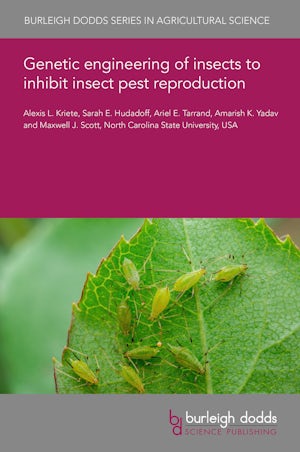

This chapter reviews key few methods of genetic biocontrol focusing on those systems that have been developed for crop insect pests. These include “sterile release systems” where e.g. sterilized males produce sperm which carries dominant lethal mutations that result in their offspring failing to develop or prevents functional sperm from being produced. We contrast these systems with “fertile release systems” which involve releasing insects that are capable of producing some offspring but with genetic defects that e.g. mean that fewer females survive. The chapter discusses the varied strengths and weaknesses of these different systems.
- Price: $32.50
- Pages: 40
- Publisher: Burleigh Dodds Science Publishing
- Imprint: Burleigh Dodds Science Publishing
- Series: Burleigh Dodds Series in Agricultural Science
- Publication Date: 3rd April 2025
- Illustration Note: Color tables, photos and figures
- ISBN: 9781835453643
- Format: eBook
- BISACs:
TECHNOLOGY & ENGINEERING / Agriculture / Agronomy / Crop Science
TECHNOLOGY & ENGINEERING / Agriculture / Sustainable Agriculture
TECHNOLOGY & ENGINEERING / Pest Control
- 1 Introduction
- 2 Sterile release systems: the sterile insect technique
- 3 Sterile release systems: precision-guided sterile insect technique
- 4 Sterile release systems: release of insects carrying a dominant lethal/female-specific release of insects carrying a dominant
- 5 Fertile-release systems: X-poisoning, X-shredder, Y-linked editor, and homing gene drive approaches
- 6 Case study: split homing gene drive in an agricultural pest (
- 7 From the lab to the field: risk assessment and cage and open-field trials
- 8 Conclusion and future trends
- 9 Where to look for further information
- 10 Acknowledgments
- 11 References
This chapter reviews key few methods of genetic biocontrol focusing on those systems that have been developed for crop insect pests. These include “sterile release systems” where e.g. sterilized males produce sperm which carries dominant lethal mutations that result in their offspring failing to develop or prevents functional sperm from being produced. We contrast these systems with “fertile release systems” which involve releasing insects that are capable of producing some offspring but with genetic defects that e.g. mean that fewer females survive. The chapter discusses the varied strengths and weaknesses of these different systems.
- Price: $32.50
- Pages: 40
- Publisher: Burleigh Dodds Science Publishing
- Imprint: Burleigh Dodds Science Publishing
- Series: Burleigh Dodds Series in Agricultural Science
- Publication Date: 3rd April 2025
- Illustrations Note: Color tables, photos and figures
- ISBN: 9781835453643
- Format: eBook
- BISACs:
TECHNOLOGY & ENGINEERING / Agriculture / Agronomy / Crop Science
TECHNOLOGY & ENGINEERING / Agriculture / Sustainable Agriculture
TECHNOLOGY & ENGINEERING / Pest Control
- 1 Introduction
- 2 Sterile release systems: the sterile insect technique
- 3 Sterile release systems: precision-guided sterile insect technique
- 4 Sterile release systems: release of insects carrying a dominant lethal/female-specific release of insects carrying a dominant
- 5 Fertile-release systems: X-poisoning, X-shredder, Y-linked editor, and homing gene drive approaches
- 6 Case study: split homing gene drive in an agricultural pest (
- 7 From the lab to the field: risk assessment and cage and open-field trials
- 8 Conclusion and future trends
- 9 Where to look for further information
- 10 Acknowledgments
- 11 References












